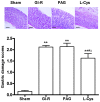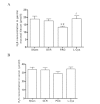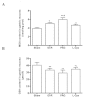Protective effect of endogenous hydrogen sulfide against oxidative stress in gastric ischemia-reperfusion injury
- PMID: 23403765
- PMCID: PMC3570130
- DOI: 10.3892/etm.2012.870
Protective effect of endogenous hydrogen sulfide against oxidative stress in gastric ischemia-reperfusion injury
Abstract
Hydrogen sulfide (H(2)S) is a gaseous signaling molecule, which plays a critical role in a number of physiological and pathological progresses. In order to determine the effect of endogenous H(2)S on gastric ischemia-reperfusion (GI-R), we evaluated the gastric mucosal damage in rats intraperitoneally injected with DL-propargylglycine (PAG, 50 mg/kg/day) or L-cysteine (L-cys, 50 mg/kg/day) for 7 days before GI-R. GI-R injury was achieved by clamping the celiac artery for 30 min, followed by reperfusion for 60 min. Gastric mucosal damage was macroscopically assessed in the area of injury and deep damage was assessed by histopathological scoring. PAG increased the area of gastric mucosal injury and deep damage compared with that in untreated GI-R rats (P<0.05). While PAG decreased the H(2)S concentration and cystathionine γ-lyase (CSE) expression in the gastric mucosa, L-cys significantly attenuated the effects of GI-R. Western blot analysis revealed that the increases of malondialdehyde (MDA) and xanthine oxidase (XOD), and decreases of glutathione (GSH), superoxide dismutase (SOD) and the restriction of superoxide (O(2) (-)) production in the PAG group were inhibited by L-cys (P<0.05). Endogenous H(2)S has a protective effect against GI-R in rats by inhibiting oxygen free radical overproduction.
Keywords: DL-propargylglycine; gastric ischemia-reperfusion injury; hydrogen sulfide; oxidative stress.
Figures






Similar articles
-
Exogenous and Endogenous Hydrogen Sulfide Protects Gastric Mucosa against the Formation and Time-Dependent Development of Ischemia/Reperfusion-Induced Acute Lesions Progressing into Deeper Ulcerations.Molecules. 2017 Feb 15;22(2):295. doi: 10.3390/molecules22020295. Molecules. 2017. PMID: 28212299 Free PMC article.
-
Cellular and molecular mechanisms of 17beta-estradiol postconditioning protection against gastric mucosal injury induced by ischemia/reperfusion in rats.Life Sci. 2010 Jan 2;86(1-2):30-8. doi: 10.1016/j.lfs.2009.11.001. Epub 2009 Nov 24. Life Sci. 2010. PMID: 19931544
-
Hydrogen sulfide protects rat lung from ischemia-reperfusion injury.Life Sci. 2008 Jun 6;82(23-24):1196-202. doi: 10.1016/j.lfs.2008.04.005. Epub 2008 May 15. Life Sci. 2008. PMID: 18482739
-
The impact of asymmetric dimethylarginine (ADAMA), the endogenous nitric oxide (NO) synthase inhibitor, to the pathogenesis of gastric mucosal damage.Curr Pharm Des. 2013;19(1):90-7. doi: 10.2174/13816128130113. Curr Pharm Des. 2013. PMID: 22950506 Review.
-
Carbon Monoxide Being Hydrogen Sulfide and Nitric Oxide Molecular Sibling, as Endogenous and Exogenous Modulator of Oxidative Stress and Antioxidative Mechanisms in the Digestive System.Oxid Med Cell Longev. 2020 Apr 15;2020:5083876. doi: 10.1155/2020/5083876. eCollection 2020. Oxid Med Cell Longev. 2020. PMID: 32377300 Free PMC article. Review.
Cited by
-
The cystathionine-γ-lyase inhibitor DL-propargylglycine augments the ability of L-cysteine ethyl ester to overcome the adverse effects of morphine on breathing.Am J Physiol Lung Cell Mol Physiol. 2025 Jun 1;328(6):L809-L825. doi: 10.1152/ajplung.00003.2025. Epub 2025 Mar 18. Am J Physiol Lung Cell Mol Physiol. 2025. PMID: 40099842 Free PMC article.
-
Effects of Sanguis Draconis on Perforator Flap Survival in Rats.Molecules. 2016 Sep 26;21(10):1262. doi: 10.3390/molecules21101262. Molecules. 2016. PMID: 27681718 Free PMC article.
-
Hydrogen Sulfide in Physiology and Diseases of the Digestive Tract.Microorganisms. 2015 Nov 12;3(4):866-89. doi: 10.3390/microorganisms3040866. Microorganisms. 2015. PMID: 27682122 Free PMC article. Review.
-
Protective Effects of H2S Donor Treatment in Experimental Colitis: A Focus on Antioxidants.Antioxidants (Basel). 2023 Apr 28;12(5):1025. doi: 10.3390/antiox12051025. Antioxidants (Basel). 2023. PMID: 37237891 Free PMC article.
-
Exogenous and Endogenous Hydrogen Sulfide Protects Gastric Mucosa against the Formation and Time-Dependent Development of Ischemia/Reperfusion-Induced Acute Lesions Progressing into Deeper Ulcerations.Molecules. 2017 Feb 15;22(2):295. doi: 10.3390/molecules22020295. Molecules. 2017. PMID: 28212299 Free PMC article.
References
-
- Wang R. Two’s company, three’s a crowd: can H2S be the third endogenous gaseous transmitter? FASEB J. 2002;16:1792–1798. - PubMed
-
- Jiang LH, Luo X, He W, Huang XX, Cheng TT. Effects of exogenous hydrogen sulfide on apoptosis proteins and oxidative stress in the hippocampus of rats undergoing heroin withdrawal. Arch Pharm Res. 2011;34:2155–2162. - PubMed
-
- Whiteman M, Armstrong JS, Chu SH, Jia-Ling S, Wong BS, Cheung NS, Halliwell B, Moore PK. The novel neuro-modulator hydrogen sulfide: an endogenous peroxynitrite ‘scavenger’? J Neurochem. 2004;90:765–768. - PubMed
LinkOut - more resources
Full Text Sources
